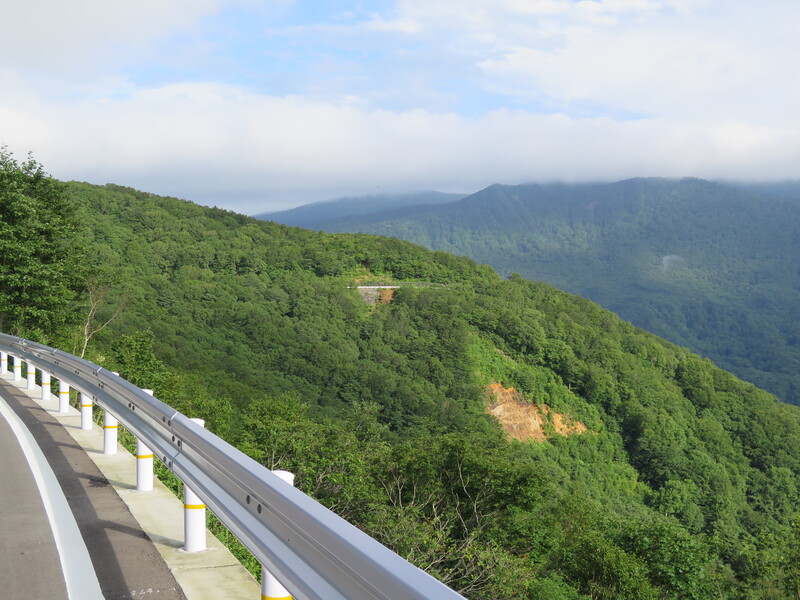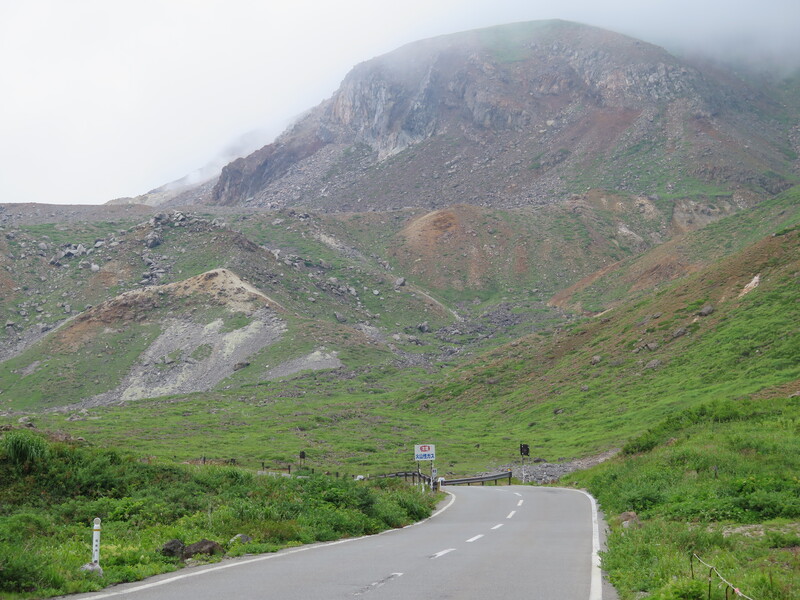Bandai Azuma Skyline
2014-08-12
It's summer vacation and time for a road trip. The dance recital last Saturday and Sunday was great, and now it's time to go north, to the mountains, and away from the Tokyo heat. In general, I plan to visit some friends and ride some motorcycle roads: the Bandai-Azuma Skyline, the Hachimantai Aspite Line, and perhaps some others depending on time, energy, and the weather. Checking off roads is nice, but there are plenty of roads and you can't ride them all, which means there's no particular rush to get anywhere.
In the wind are pungent odors from the marshes by the road. We are in an area of the Central Plains filled with thousands of duck hunting sloughs, heading northwest from Minneapolis toward the Dakotas. This highway is an old concrete two-laner that hasn’t had much traffic since a four-laner went in parallel to it several years ago. When we pass a marsh the air suddenly becomes cooler. Then, when we are past, it suddenly warms up again. I’m happy to be riding back into this country. It is a kind of nowhere, famous for nothing at all and has an appeal because of just that.
— Robert Pirsig, Zen and the Art of Motorcycle Maintenance (1974).
It takes some time to get in and out of Tokyo. The roads within the metropolitan area are less crowded at night. Also, the expressway is 30% cheaper if you enter, exit, or are on it between midnight and 4AM. It is reasonable, if you don't mind a bit of night driving, to leave in the evening and drive until a little after midnight. Tonight I'm hoping to get to a rest area near Fukushima City.
I want to go north, and the nearest north-bound expressway to my apartment is the Tokyo Gaikan Expressway (東京外環自動車道). It takes maybe an hour of city driving to get to the expressway entrance at the Oizumi Interchange. Which roads you take matters a lot. If you're near the Chuo Line or the Seibu Shinjuku Line in western Tokyo, Ome Kaido (青梅街道) and Shin Ome-Kaido (新青梅街道) are relatively fast east-west local roads.
Once you're on the Tokyo Gaikan Expressway, it's a fairly quick trip NE to the Tohoku Expressway, which is the major north-south expressway in eastern Japan. The Tokyo sprawl extends far to the north. It is probably a bad idea to try to take local roads until you're north of Utsunomiya. The expressway is a toll road, and paying the toll sucks, but spending twice or three times as long muddling through stop-and-go traffic sucks more. Take the financial hit, take the toll road out of town, and get to places with fewer traffic lights and cars and more more corners and mountain passes.
Chris and I are traveling to Montana with some friends riding up ahead, and maybe headed farther than that. Plans are deliberately indefinite, more to travel than to arrive anywhere. We are just vacationing. Secondary roads are preferred. Paved county roads are the best, state highways are next. Freeways are the worst. We want to make good time, but for us now this is measured with emphasis on "good" rather than "time" and when you make that shift in emphasis the whole approach changes. Twisting hilly roads are long in terms of seconds but are much more enjoyable on a cycle where you bank into turns and don’t get swung from side to side in any compartment. Roads with little traffic are more enjoyable, as well as safer. Roads free of drive-ins and billboards are better, roads where groves and meadows and orchards and lawns come almost to the shoulder, where kids wave to you when you ride by, where people look from their porches to see who it is, where when you stop to ask directions or information the answer tends to be longer than you want rather than short, where people ask where you’re from and how long you’ve been riding.
— Robert Pirsig, Zen and the Art of Motorcycle Maintenance (1974).
Traveling light is ideal. When I go backpacking, I often go ultralite, but the motorcycle has an engine and keeps me in the front country where the roads are. So I ought to bring a little more. This time around I'm bring my tent, Therm-A-Rest, sleeping bag, three days of clothes, and a few assorted odds and ends. Subject to minor modifications, the picture shows the collection.
- Small 2-person tent.
- Ground cloth.
- Small Therm-A-Rest air mattress.
- Summer-weight sleeping bag.
- Compression sack for the sleeping bag.
- Travel towel.
- Sunglasses.
- Body wipes.
- Ibuprofen.
- First aid kit.
- Headlamp.
- Wallet.
- Eye drops.
- Keys.
- Canon PowerShot G16 camera.
- Camera battery charger.
- 2 USB battery packs.
- 2 USB chargers.
- Samsung Galaxy S 3 phone.
- Headphones.
- A book.
- 1 pair of Dickies slacks.
- 1 pair of Edwin jeans.
- 1 pair of athletic shorts.
- 3 nylon T-shirts.
- 3 pairs of socks.
- 3 pairs of underwear.
- 1 pair of flip flops.
- 1 pair of New Balance waterproof shoes.
- Summer riding jacket.
- Summer motorcycle gloves.
- Waterproof motorcycle gloves.
- Rain suit.
- Gaiters.
- Saddlebag rain covers.
- Helmet.
- Towel for helmet.
- Registration papers.
- Insurance papers.
- Saddlebags.
- A handful of Ziploc bags.
The first night I left Tokyo at 9PM and drove five hours north to a rest area near Fukushima City. The drive would have been faster, but I missed a turn in Tokyo and that added half an hour. Night driving on the expressway is not notable, because there are no views but despite being nighttime, it is not particularly quiet. Before leaving, the odometer read 6716 km.
On the second day, I drove the famous Bandai-Azuma Skyline in western-central Fukushima. The night before was windy as hell, on account of a typhoon passing nearby. I slept poorly in my tent at a rest area. The rain fly was old, and apparently I hadn't stored it properly, because seams ripped out overnight and by morning it was useless. It was a calm sunny morning
Around 10:30, the rain came, and it lingered all day. After a barbeque pork lunch in a Zao ski resort town, I crossed the Zao Echoline. I rode this road going the other direction last year. It's fun going both ways.
In the late afternoon, tired and waterlogged, I stopped at the Route Inn near Shinjo Station for the night. The hotel room had a TV, but other than pay-per-view it only had four channels. When traveling with my family growing up, I remember hotels typically only had the broadcast TV channels, which is what this was, but you'd think with increases in technology, they'd have upgraded at some point. Apparently not! The pillow was uncomfortable, too. But the bed was nice, the room was clean, and I slept for twelve hours.





